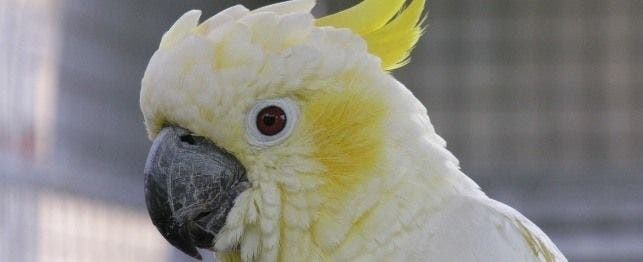
Choosing a Lesser Sulphur-Crested Cockatoo
Lesser sulphur-crested cockatoos are also known as dwarf sulphur-crested cockatoos or Timor cockatoos. These cockatoos are found on Sulawesi Island in Indonesia. They inhabit forest edge, woodland and cultivated areas, and are sparsely distributed throughout their range. Lesser sulphur-crested cockatoos are active, high-energy birds. They are gentle and playful, but tend to be shy. Lesser sulphur-crested don’t often speak well. They are not so demanding and possessive as the larger white cockatoos.
Lesser sulphur-crested cockatoos (Cacatua sulphurea sulphurea) can live up to 40 years. Precise data on life span of the average lesser sulphur-crested cockatoo is poorly documented. Many succumb to disease or injury rather than living for their potential life span.
Appearance and Personality
Lesser sulphur-crested cockatoos are small white cockatoos with a yellow recurved crest. They can be distinguished from medium sulphur crested cockatoos by size and the presence of a large yellow ear patch in the lesser sulphur-crested. The underside of the flight feathers are yellow.
Lesser sulphur-crested cockatoos are inquisitive and love to chew objects in their surroundings but are not as destructive as other cockatoos. They should always be provided with toys, blocks of wood or branches that they can chew. In order to ensure safety companion cockatoos should not be allowed unsupervised freedom in the home as they often encounter toxins or dangerous items. Young cockatoos should be socialized to many people and exposed to a variety of situations such as new cages, toys, visits to the veterinarian, handling by friends, wing and nail clips, etc. to avoid fear of novel situations. They need to have some space for exercise.
Feeding
Cockatoos should be fed a formulated (pelleted or extruded) diet as a basis for good nutrition. The diet should be supplemented with fresh fruits and vegetables daily to add variety and psychological enrichment. Feed approximately 1/4 cup of pellets and 1/4 cup of fresh fruits and vegetables daily. Monitor food intake in order to prevent obesity. Overfeeding leads to obesity, pickiness, wastage and throwing food. Low fat seeds, such as millet, especially spray millet is a good treat food. High fat seeds should not be fed.
Adult and juvenile lesser sulphur-crested cockatoos are efficient in utilization of calories and are picky eaters. Try to ensure that the food that they eat is nutritious and avoid high fat seeds such as sunflower and safflower. Vitamin supplements are not needed for birds that are eating a formulated diet.
Grooming
Routine bathing or showering is vital to maintaining good plumage and skin condition. Birds can be misted and allowed to dry in a warm room or in the sun, or gently dried with a blow drier. Care should be taken not to clip the wing feathers excessively as cockatoos often fall and injure themselves. Clip only the primary flight feathers and only enough so the bird will glide to the floor. Lesser sulphur-crested are better flyers than Moluccans and umbrellas and a few more feathers should be removed.
Housing
Lesser sulphur-crested cockatoos are very active and should be provided the largest cage that space and budget allows. Ideally the cage should provide room for flight. Durable cage construction is not as critical as lesser sulphur-cresteds are not such strong chewers as larger cockatoos. Many are adept at opening cage latches. Locks or escape proof latches may be necessary on cages. The cage should be as large as possible but must allow at least enough room to fully spread the wings. Ideally the bird will have an outdoor cage as well to allow playtime in the fresh-air and sunlight.
Breeding
Lesser sulphur-crested cockatoos breed well fairly well in captivity but are not bred as frequently as Moluccans and umbrellas. In North America, lesser sulphur-crested cockatoos breed predominantly in the winter and spring. Clutch size is typically 2 to 3 eggs. One inch by one inch by 12 gauge welded wire is a good choice for cage construction. A suggested size is 4 feet wide by 4 feet tall by 6 feet long suspended 4 feet above the ground or floor.
Double entrance nest boxes are often used to reduce the chance of the male trapping the female in the box. Grandfather style wooden boxes can be used. Size should be approximately 12 inch by 12 inch by 24 inch or 12 inch by 12 inch by 36 inch.
Incubation period is approximately 24 to 26 days. Chicks will usually fledge at approximately 8 to 10 weeks of age. Lesser sulphur-crested cockatoos are relatively easy to hand-rear. Most hand rearing formulas can be used successfully.
Male cockatoos frequently become aggressive toward their mates. Cage construction and management should take into consideration techniques to reduce mate aggression. Clipping the wings of the male prior to the breeding season will help the female to escape in case the male becomes aggressive. Aggressive behavior may occur in compatible breeding pairs.
When breeding cockatoos, noise and proximity to neighbors must be considered. If housed outdoors cockatoos often call at night especially during a full moon. In southern states outdoor caging must be protected from opossums to prevent exposure to the parasite Sarcocystis falcatula, which can result in a fatal lung infection.
Common Diseases and Disorders
Cockatoos are relatively healthy birds but are susceptible to the following:
- Psittacine Beak and Feather Disease (Common in the wild population)
- Feather-picking
- Psittacosis
- Mate aggression
- Poor eating habits
- Bacterial and fungal infections
- Sarcocystis
- Toxicity, ingestion of metals